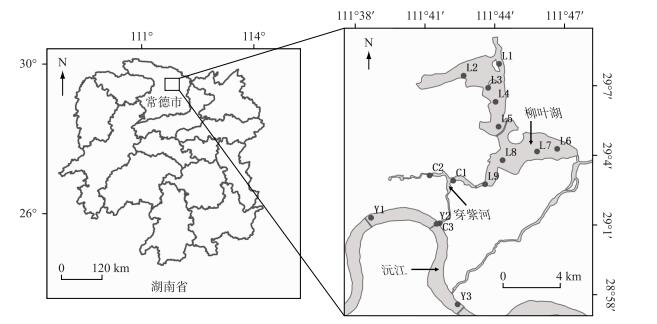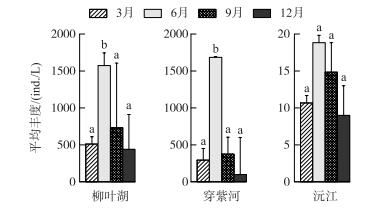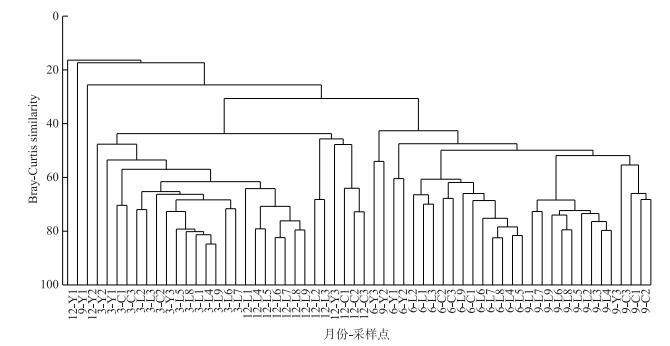(2: 生态环境部华南环境科学研究所, 广州 510530)
(2: South China Institute of Environmental Sciences, Ministry of Ecology and Environment, Guangzhou 510530, P. R. China)
轮虫是一种低等无脊椎动物,几乎存在于所有类型的淡水环境,对维持水域生态系统结构功能及次级生产力具有重要作用[1-2].轮虫对环境变化反应敏感,具有生命周期短和种群重建快的特点,是评价水体营养状况的理想生物指标[3-4].定期监测轮虫群落结构动态变化是了解水域生态系统结构和功能的重要途径.轮虫群落结构的时空变化受生物因素如食物资源、捕食和竞争以及非生物因素如水温、溶解氧和营养盐等共同影响[5-6].
国内外已有较多对湖泊、河流和水库轮虫群落研究的报道[7, 9].许多学者对不同湖泊轮虫群落结构调查发现其丰度和生物量均存在季节性差异[10],各个湖泊轮虫丰度达到最高峰的时间不完全相同,而生物量的最高峰大都出现在春夏季[11-15].湖泊为静水系统,为轮虫迅速繁殖提供稳定的水生环境;而河流水体流动性强,水生环境复杂,为轮虫种类多样性提供生境条件,对Kaw河研究发现丰水期和枯水期的变化是影响轮虫群落的主要因素[16].水库是由动、静水体组成的特殊生态系统,研究表明水库理论水滞留时间(WRT)是轮虫群落结构的主要影响因素[17].目前对河-湖连通水系轮虫群落结构鲜有研究[18],河-湖连通使不同水文特征的水体相连,增强水体环境异质性,为提高水生生物多样性提供了生境条件[19]. Casanova等[20]研究发现河-湖连通会影响湖泊的稳定性,且具有季节性,从而影响轮虫的丰度、生物量和次级生产力.河-湖连通水系中的异质性是影响生态系统非生物和生物特征的关键因素[21-22].城市河-湖连通可达到纳污净化、调蓄防洪和提高河流自净能力等重要生态功能,是城市健康水系的重要载体[23].
常德市地处湖南省北部,受亚热带季风气候控制,四季分明,2015年被列为全国“海绵城市”首批试点城市[].由于早年多个排污口及泵站向穿紫河内排放污水,水体严重污染,导致穿紫河成为城市的纳污水体[]. 2002年“引沅济穿”提水工程与2016年柳叶湖、穿紫河正式连通,柳叶湖闸口和穿紫河闸口分别是柳叶湖和穿紫河、穿紫河和沅江的连接闸口. 3个水体连通形成一块巨大的“海绵”,不仅消纳城市超量雨水,并部分恢复了穿紫河的自净功能,稀释了穿紫河的污染,水质逐步好转.柳叶湖、穿紫河和沅江相连构成特有的湖泊-河流湿地生态系统,为轮虫提供丰富多样的生境.本文于2018年对常德柳叶湖及其邻近水体穿紫河和沅江进行4个季度的采样和环境指标的分析,对水环境质量进行评估,探讨了不同水体轮虫群落结构的时空动态变化及其与环境因子的关系,分析轮虫群落结构特征对不同水体连通性和异质性的响应,以期为亚热带河-湖连通水系生物多样性保护和水环境管理提供基础资料和科学依据.
1 材料与方法 1.1 样点设置和采样时间2018年3月(春季)、6月(夏季)、9月(秋季)、12月(冬季)对湖南常德柳叶湖及其邻近水体进行采样,共设置15个站点,其中柳叶湖9个站点(L1~L9)、穿紫河3个站点(C1~C3)、沅江3个站点(Y1~Y3)(图 1).

|
图 1 常德柳叶湖及其邻近水体采样站点 Fig.1 Sampling sites of Lake Liuye and its adjacent waters in Changde City |
使用YSI plus水质分析仪(美国)对水温(Temp)、pH和溶解氧(DO)进行现场测定;使用萨氏盘测定水体透明度(SD).在各采样点采集水样,于实验室内按国家地表水环境质量标准GB 3838-2002[26]测定总氮(TN)、总磷(TP)和氨氮(NH3-N)浓度,用丙酮分光光度法测定叶绿素a(Chl.a)浓度,化学需氧量(CODMn)用高锰酸钾法测定[26].
轮虫定性样品:采用孔径38 μm浮游生物网垂直和水平拖取,加入甲醛溶液至终浓度为4 %固定保存.定量样品:用孔径20 μm浮游生物网过滤浓缩4~10 L水样,收集至50 mL聚乙烯瓶中,加入甲醛溶液至最终浓度为4 %固定保存.种类鉴定依据Koste分类系统[]和《中国淡水轮虫志》[]鉴定.将定量样品浓缩至10 mL,摇匀后取1 mL在显微镜下于计数框计数,每个样品计数2片取平均值,每片计数误差不超过20 %.
1.3 数据处理使用SPSS 16.0软件对轮虫丰度、多样性指数和环境因子进行单因素方差分析(ANOVO).使用PRIMER 5软件基于Bray-Curtis距离对样方和物种组成进行CLUSTER(聚类分析)分析.使用Canoco 4.5对轮虫种类进行去趋势对应分析(DCA),如果4个轴中梯度最大值超过4,属于单峰型模型,使用典范对应分析(CCA);如果小于3,属于线性模型,使用冗余分析(RDA).通过前向选择对主要环境因子进行筛选,去除自相关变量.采样站点图采用ArcGIS 10.0绘制.
1) 采用Margalef丰富度指数(d)、Shannon-Wiener指数(H′)、Pielou均匀度指数(J)评价轮虫群落多样性,其公式分别为:
| $ {d = (S - 1)/{\rm{ln}}{\kern 1pt} {\kern 1pt} N} $ | (1) |
| $ {{H^\prime } = - \sum\limits_{i = 1}^S {({n_i}/N)} {\rm{lo}}{{\rm{g}}_2}({n_i}/N)} $ | (2) |
| $ {J = {H^\prime }/{\rm{lo}}{{\rm{g}}_2}S} $ | (3) |
2) 优势度(Y):
| $ Y = {f_i}({n_i}/N) $ | (4) |
式中,S为种类数,ni为第i种的个体数,N为样品中所有种类总个体数, fi为第i种出现的频率,Y > 0.02为优势种[29].
3) 采用杰卡特(Jaccard)群落相似性系数(K)对不同水体出现的轮虫群落进行分析,其公式如下:
| $ K = \frac{c}{{a + b - c}} $ | (5) |
式中,c为群落A与B的共有种数;a为群落A含有的全部种数;b为群落B含有的全部种数,K值在0~0.25为极不相似,0.25~0.50为中等不相似,0.50~0.75为中等相似,0.75~1.00为极相似[30].
4) 以Chl.a浓度为基准,TN、TP、SD和CODMn相关加权综合营养状态指数评价水体营养状态.营养状态计算公式如下:
| $ TLI({\rm{ Chl}}{\rm{. }}a) = 10(2.5 + 1.086{\rm{ln}}{\kern 1pt} {\kern 1pt} {\kern 1pt} {\rm{Chl}}{\rm{. }}a) $ | (6) |
| $ {TLI({\rm{TP}}) = 10(9.436 + 1.624{\kern 1pt} {\kern 1pt} {\kern 1pt} {\rm{ln}}{\kern 1pt} {\kern 1pt} {\kern 1pt} {\rm{TP}})} $ | (7) |
| $ {TLI({\rm{TN}}) = 10(5.453 + 1.694{\kern 1pt} {\kern 1pt} {\kern 1pt} {\rm{ln}}{\kern 1pt} {\kern 1pt} {\kern 1pt} {\rm{TN}})} $ | (8) |
| $ {TLI({\rm{SD}}) = 10(5.118 - 1.94{\kern 1pt} {\kern 1pt} {\kern 1pt} {\rm{ln}}{\kern 1pt} {\kern 1pt} {\kern 1pt} {\rm{SD}})} $ | (9) |
| $ {TLI({\rm{CO}}{{\rm{D}}_{{\rm{Mn}}}}) = 10(0.109 + 2.661{\kern 1pt} {\kern 1pt} {\kern 1pt} {\rm{ln}}{\kern 1pt} {\kern 1pt} {\kern 1pt} {\rm{CO}}{{\rm{D}}_{{\rm{Mn}}}})} $ | (10) |
式中,Chl.a单位为mg/m3,SD单位为m;其他指标单位均为mg/L.
相关加权综合营养状态指数公式为:
| $ TLIc = \sum {{W_j}} \cdot TL{I_{(j)}} $ | (11) |
式中,TLIc(Σ)为综合营养状态指数;Wj为第j种参数的营养状态指数的相关权重;TLI(j)代表第j种参数的营养状态指数.其中,营养状态分级为:TLI(Σ) < 30时为贫营养;30≤TLI(Σ)≤50时为中营养;TLI(Σ)>50时为富营养;50 < TLI(Σ)≤60时为轻度富营养;60 < TLI(Σ)≤70时为中度富营养;TLI(Σ)>70时为重度富营养[31].
2 结果 2.1 3个水体的理化环境特征调查期间柳叶湖、穿紫河和沅江3个水体理化因子呈现较为剧烈的周年变化(图 2).平均水温为19.4±8.24℃,其中最高水温为30℃(6月),最低水温为7.5℃(12月). Chl.a和TP最高值出现在3月C2穿紫河(74.3 μg/L和0.27 mg/L),且明显高于其他月份和水体(P < 0.05).该连通水系TLIc值处于30~70之间,通过计算3个水体TLIc值年平均值,营养状态水平高低呈现:穿紫河(63.7±8.8)>柳叶湖(54.6±7.6)>沅江(47.4±6.4),其中穿紫河和柳叶湖已达到富营养化水平.全年水温、DO、CODMn、TN和TLIc值呈现春冬季和夏秋季分化(P < 0.05),pH无明显季节变化(P > 0.05).

|
图 2 常德柳叶湖及其邻近水体理化指标参数平均值(不同字母(a、b、c、d)表示平均值之间存在显著性差异(P < 0.05)) Fig.2 Physical-chemical parameters in Lake Liuye and its adjacent waters in Changde City (Different letters (a, b, c, d) indicate significant difference (P < 0.05) between mean values) |
本调查共检出河-湖连通中3个水体轮虫共29属88种(包括亚种8种和变种1种)(表 1),其中,柳叶湖78种,穿紫河63种,沅江37种.种属组成以臂尾轮属(19 %)、异尾轮属(10 %)、腔轮属(10 %)和三肢轮属(7 %)种类居多.
| 表 1 常德柳叶湖及其邻近水体轮虫种类名录* Tab. 1 Species composition of rotifers in Lake Liuye and its adjacent waters in Changde City |
比较不同水体和不同季节轮虫群落之间Jaccard群落相似性系数发现:不同水体中,柳叶湖和穿紫河呈现中等相似(0.61),沅江与柳叶湖和穿紫河均呈现中等不相似(0.42和0.44);不同季节中,3月与12月以及6月与9月均呈现中等相似(0.52和0.58),呈现春冬季和夏秋季分化现象.
调查期间,由于水体连通,3个水体全年第一优势种均为长肢多肢轮虫.柳叶湖轮虫群落中优势种丰度组成所占比例较大,群落结构趋于单一(图 3).在连通水系中,优势种分布存在季节差异.螺形龟甲轮虫较多分布于水温较高的夏、秋两季,尖尾疣毛轮虫集中分布于水温较低的春、冬两季,长肢多肢轮虫广泛分布于3个水体和各个季节.

|
图 3 常德柳叶湖及其邻近水体轮虫优势种组成季节变化 Fig.3 The seasonal changes of dominant rotifer species in Lake Liuye and its adjacent waters in Changde City |
常德河-湖连通水系轮虫丰度全年波动较大,呈现季节性差异.全年轮虫最高丰度出现在6月C3穿紫河闸口,为2535 ind./L. 3个水体轮虫平均丰度随水温下降趋势依次递减:6月>9月>3月>12月(图 4),具有季节性演替特征.柳叶湖、穿紫河轮虫年平均丰度远高于沅江(P < 0.01).方差分析显示,沅江4个季度轮虫平均丰度差异不显著;柳叶湖和穿紫河情况相似,且6月均显著高于其他月份(P < 0.05),其他季节之间差异不显著(P>0.05).

|
图 4 常德柳叶湖及其邻近水体轮虫平均丰度(不同字母(a、b)表示平均值之间存在显著性差异(P < 0.05)) Fig.4 The average abundance of rotifers in Lake Liuye and its adjacent waters in Changde City(Different letters (a, b) indicate significant difference (P < 0.05) between mean values) |
调查期间,Margalef丰富度指数(d)年均值为3.24±0.97,3个水体差异不显著(P>0.05)(图 5).均匀度指数(J)年平均值为0.71±0.16,3个水体间呈现显著差异(P < 0.05),其年平均值依次递减:沅江>穿紫河>柳叶湖. Shannon-Wiener指数(H′)年均值为2.81±0.57,穿紫河显著高于柳叶湖和沅江(P < 0.05).常德河-湖连通水系轮虫群落结构聚类分析显示(图 6),相似水平为45 %时,显示3月和12月以及6月和9月分别聚为两类,呈现明显的春冬-夏秋分化模式.

|
图 5 常德柳叶湖及其邻近水体轮虫多样性指数的比较(不同字母(a、b、c)表示平均值之间存在显著性差异(P < 0.05)) Fig.5 Comparison among diversity indices of rotifers in Lake Liuye and its adjacent waters in Changde City (Different letters (a, b, c) indicate significant difference (P < 0.05) between mean values) |

|
图 6 常德柳叶湖及其邻近水体轮虫群落结构聚类分析 Fig.6 Cluster analysis of rotifer community structure in Lake Liuye and its adjacent waters in Changde City |
对3个水体主要优势轮虫群落进行去趋势分析(DCA),排序结果显示4个轴最大长度为15,属于单峰型模型,使用典范对应分析(CCA)环境因子对轮虫群落的影响.排序的全部特征值解释了轮虫群落变异程度的41.6 %,前两轴共解释了轮虫变异程度的32.3 % (表 2). CCA分析表明水温是影响连通水系轮虫群落最重要的环境因子.从不同季节和不同水体分布来看(图 7A),6月和9月之间物种差异性较小,主要受水温、TN、CODMn、Chl.a和pH影响较大. 3月和12月3个水体间物种差异性较大,6月和9月各水体物种组成差异性较小. 3月和12月均与其他月份物种差异性较大,3月不同水体主要受TP影响较大,12月不同水体主要受DO、SD和NH3-N影响较大.
| 表 2 常德柳叶湖及其邻近水体轮虫种类和环境因子CCA分析统计信息 Tab. 2 Statistical information of CCA between rotifer species and environmental factors in Lake Liuye and its adjacent waters in Changde City |

|
图 7 各季节和不同水体与环境因子间的CCA排序图(三角形:柳叶湖,菱形:穿紫河,圆形:沅江,绿色:3月,黄色:6月,蓝色:9月,灰色:12月)(A), 轮虫分布与环境因子之间的CCA排序图(1:脾状三肢轮虫,2:微小三肢轮虫,3:广布多肢轮虫,4:污前翼轮虫,5:S. vorax,6:梳状疣毛轮虫,7:长圆疣毛轮虫,8:尖尾疣毛轮虫,9:长肢多肢轮虫,10:无棘螺形龟甲轮虫,11:西氏晶囊轮虫,12:真翅多肢轮虫,13:前节晶囊轮虫,14:独角聚花轮虫,15:东京犀轮虫,16:舞跃无柄轮虫,17:卵形无柄轮虫,18:卜氏晶囊轮虫,19:红多肢轮虫,20:螺形龟甲轮虫,21:微型多突轮虫,22:裂痕龟纹轮虫,23:尾突臂尾轮虫,24:剪形臂尾轮虫,25:奇异六腕轮虫,26:角突臂尾轮虫,27:镰状臂尾轮虫,28:裂足臂尾轮虫,29:等棘异尾轮虫,30:暗小异尾轮虫,31:长三肢轮虫)(B) Fig.7 CCA ordination among seasons, different waters and environmental factors (Triangle: Lake Liuye, rhombus: Chuanzi River, circle: Yuan River. Green: March, yellow: June, blue: September, grey: December) (A), CCA ordination between rotifers distribution and environmental factors (1: F. opoliensis, 2: F. minuta, 3: P. vulgaris, 4: P. sordida, 5: S. vorax, 6: S. pectinate, 7: S. oblonga, 8: S. stylata, 9: P. dolichoptera, 10: K. tecta, 11: A. sieboldii, 12: P. euryptera, 13: A. priodonta, 14: C. unicornis, 15: R. tokioensis, 16: A. saltans, 17: A. ovalis, 18: A. brightwellii, 19: P. remata, 20: K. cochlearis, 21: P. subtilis, 22: A. fissa, 23: B. caudatus, 24: B. forficula, 25: H. mira, 26: B. angularis, 27: B. falcatus, 28: B. diversicornis, 29: T. similis, 30: T. pusilla, 31: F. longiseta)(B) |
从轮虫种类分布来看(图 7B),臂尾轮属、异尾轮属和龟甲轮属受CODMn、TN和水温影响较大且呈正相关关系;疣毛轮属受TP和DO影响较大且呈正相关关系;无柄轮属、晶囊轮属、聚花轮属和犀轮属受SD影响较大且呈正相关关系;多肢轮属位于排序轴中心位置,受环境因子变化的影响较小.
| 表 3 CCA前2轴与环境因子之间的相关系数 Tab. 3 Correlation coefficients between environmental factors and the first two ordination axes of CCA |
柳叶湖位于常德市区,随数条入湖河流的污染物流入,全年呈轻度富营养状态.主要污染源有生活污水、养殖污染物和农田径流污染物等[32].穿紫河是一条城市水道,流经城市区域,有大量生活污水汇入[24],同时承接了上游流域地表汇集的营养盐,TLIc在该连通水系中最高,达到中度富营养化水平.沅江常德市区河段在3个水体中水质较好[33],与穿紫河相连,最终汇入洞庭湖,其河道变宽,流速放缓,营养盐浓度稀释,泥沙颗粒充分沉降从而提高了透明度.
常德城市连通水系地处亚热带地区,调查区域多样性较高的轮虫类群为臂尾轮属、异尾轮属和腔轮属,它们均属于热带和亚热带地区常见轮虫种属[2, 34].轮虫对环境变化反应敏感,常作为评价水体营养状态的指示生物[35-36].一般认为,臂尾轮属、螺形龟甲轮虫、裂痕龟纹轮虫、沟痕泡轮虫、扁平泡轮虫、暗小异尾轮虫、圆筒异尾轮虫、长三肢轮虫、真翅多肢轮虫和矩形龟甲轮虫为富营养化湖泊的轮虫指示种[37-38].本调查中,以上10种轮虫指示种在柳叶湖和穿紫河均有出现,表明这2个水体已达到富营养化水平,与TLIc计算结果一致.
研究表明,在中营养到中度富营养水体中,随着富营养化水平提高,轮虫食物的可获得性增加,因此轮虫的丰度与富营养化程度呈正相关[39-40].本研究发现,从空间分布上,柳叶湖和穿紫河全年轮虫平均丰度显著远高于沅江(P < 0.01),随着水体富营养化程度的加剧,轮虫丰度上升,与国内其他湖泊的研究结果一致[40-42].营养盐的升高使水体富营养化加剧,从而加快浮游植物生长,充足的食物供应使轮虫丰度增加.从时间分布上,轮虫丰度时间分布与水温变化趋势相同,轮虫丰度在夏、秋季较高,与已有研究结果一致[43].夏、秋季是蓝藻暴发时期,蓝藻死亡后繁殖的大量细菌能作为轮虫的重要食物来源[13].水温升高缩短孵化和繁殖发育时间,提高了轮虫种群的周转速率,容易形成轮虫丰度高峰[44].同时夏、秋季节雨水较多,来自城市生活区和农业土壤中冲刷的大量有机碎屑和营养盐促进浮游藻类、细菌和原生动物的生长繁殖,为轮虫提供充足食物[45].因此轮虫群落结构可作为河-湖连通水系富营养化的评价依据.
3.2 影响轮虫群落变化的环境因子常德柳叶湖及其邻近水体受亚热带季风气候控制,夏季高温多雨,冬季低温少雨.本研究表明水温是影响轮虫群落的主要环境因子.同时季节性降雨会通过改变各个水域水位、流速和外源营养盐的汇入,使水文条件和水质状态出现季节性变化,最终将导致轮虫群落的季节性变化,主要表现为轮虫种类的全年分布和优势种种群动态的季节性变化[9].统计分析表明SD、DO、CODMn和TN是该连通水系轮虫群落结构变化重要的影响因子,均呈现明显的春冬-夏秋季节分化,导致轮虫群落结构呈现春冬-夏秋的季节分化模式(图 7A).
CCA排序图解释了优势种和敏感种轮虫群落与环境因子之间的关系,也反映了物种之间的生态位分化[36].调查期间,连通水系6月和12月以及全年3个水体的第一优势种均为长肢多肢轮虫.相关研究表明,其适宜生存在低氧和低温环境中[46],多肢轮虫在水中移动速度较快有利于其捕食和逃避敌害,环境耐受性较强,是广布种[42].在CCA排序图中,多肢轮属位于两轴较中间位置,受多种环境因子影响,在各个季节都有出现,在连通水系中占生态位优势.螺形龟甲轮虫较多出现在夏、秋两季,期间3个水体的营养水平较高,螺形龟甲轮虫对富营养化水体有较强的适应力[47],且具有背甲,不易被捕食,广泛出现在连通水系中,与COD及TN相关性较高,与水温呈正相关.疣毛轮属与水温呈负相关,与DO呈正相关关系.无柄轮属是广温性种类[48],而本研究中较多出现在温度较低的春、冬季,在温度较高的夏、秋季出现较少,可能由于夏、秋季雨水冲刷使水体含沙量高不利于其生长繁殖,与席贻龙[49]对青弋江芜湖段研究结果一致.富营养化指示种如臂尾轮属、暗小异尾轮虫、长三肢轮虫等在CCA排序图中与Chl.a、TN和TP相关性较高.
综上,水温是该河-湖连通水系轮虫群落结构主要影响因子,与一些亚热带水体轮虫群落结构与环境因子相关性的研究结果一致[7, 47, 50],水温可能是影响亚热带水体轮虫群落结构变化的关键因子.
3.3 轮虫群落变化对水体连通的响应水体连通是导致轮虫群落结构相似性的原因之一.柳叶湖和穿紫河轮虫群落结构为中等相似,沅江和穿紫河、柳叶湖轮虫群落结构为中等不相似,原因可能是由于柳叶湖和穿紫河直接相通且均为富营养化水体,导致轮虫群落相似.而沅江常德市区河段只有Y2沅江一桥受到柳叶湖和穿紫河上游来水的影响,使其与柳叶湖、穿紫河相似度较低. 3个水体具有相同的优势轮虫种类,反映了3个水体连通性和地理区系的综合影响.
常德河-湖连通水系由静态(柳叶湖)、动态(穿紫河和沅江)水体结合,其水文条件和水域环境异质性,在构建轮虫群落上发挥重要作用[51].轮虫对环境异质性的响应主要表现在多样性差异和丰度的空间差异[52-53].中等干扰假说提出中等程度上的环境干扰,有助于环境容纳多样化种类共存[54].穿紫河河道较窄、流速较快,流经常德市区,生活污水污染较大,水体环境较柳叶湖和沅江干扰多;且穿紫河实施了生态修复工程,种植了多种水生植物,为轮虫物种多样性提供了多样化的生境条件[55],从而使其多样性指数和丰富度指数较高,与温展明等[9]对流溪河水库的湖泊区、河流区和过渡区环境异质性的研究结果相似. Chl.a浓度是表征藻类现存量的重要指标之一[56],静水水体柳叶湖更有利于浮游植物生长繁殖,柳叶湖Chl.a浓度高于穿紫河,食物更为丰富,轮虫丰度较高.同时稳定的环境使一些特别适宜在富营养化环境下生长、繁殖的轮虫种类迅速繁殖成为优势种,丰度较高;优势种群增长率大于整个群落的平均水平,通过排斥敏感种进一步占领剩余的生态位[40],其丰度比例大于其他种轮虫(图 3),群落结构趋于简单,从而使整个群落均匀性指数和多样性指数较低[57],与Portinho等[58]对Itaipu水库研究结果一致.均匀度指数和Shannon-Wiener指数表明柳叶湖和沅江轮虫群落结构较穿紫河简单.常德3个水体轮虫群落多样性指数的不同体现了轮虫群落对环境异质性的响应,同时也从侧面验证了指示生物轮虫能够对连通水系环境变化做出指示的敏感性和优越性.
3.4 河-湖连通的生态效益常德市是“海绵城市”之一,通过河-湖连通生态系统实现有效控制雨水径流、吸纳蓄洪、自然净化等功能.一方面,城市水系连通性会增强水流的自净能力和纳污能力;另一方面,水系连通保持了生物栖息地的完整性,为提高水生生物多样性提供了生境条件[18],河流连通性是维持河流生态系统稳定的重要因素[59]. 2016年柳叶湖和穿紫河实现连通,易季纯[60]在1983-1985年间对柳叶湖的调查中共检出32种轮虫,本次调查检出78种,种数增多了两倍,物种多样性大幅度提高,说明城市河湖连通具有良好的生态效益.本研究结果表明,穿紫河水质状况较差,应重点加强对穿紫河水环境的治理,严控生活污水直接排入河道、加大污水处理工程实施、实行上游连通闸口生态调度、应用栽培水生植物净化水质等生物技术,从而有效提高常德市水环境质量.
| [1] |
Wallace RL, Snell TW, Ricci C et al. Rotifera vol. 1: biology, ecology and systematics. In: Segers H, Dumont HJ eds. Guides to the identification of the microinvertebrates of the Continental Waters of the World 23(2nd ed). Leiden: Backhuys Publishers, 2006: 1-299.
|
| [2] |
Segers H. Global diversity of rotifers (Rotifera) in freshwater. Hydrobiologia, 2008, 595(1): 49-59. DOI:10.1007/s10750-007-9003-7 |
| [3] |
Mäemets A. Rotifers as indicators of lake types in Estonia. Hydrobiologia, 1983, 104(1): 357-361. DOI:10.1007/BF00045991 |
| [4] |
Duggan IC, Green JD, Shiel RJ. Distribution of rotifers in North Island, New Zealand, and their potential use as bioindicators of lake trophic state. In: Sanoamuang L, Segers H, Shiel RJ et al eds. Rotifera IX. Developments in Hydrobiology, vol 153. Dordrecht: Springer, 2001: 155-164.
|
| [5] |
Arnott SE, Vanni MJ. Zooplankton assemblages in fishless bog lakes:influence of biotic and abiotic factors. Ecology, 1993, 74(8): 2361-2380. DOI:10.2307/1939588 |
| [6] |
Yoshida T, Urabe J, Elser JJ. Assessment of 'top-down' and 'bottom-up' forces as determinants of rotifer distribution among lakes in Ontario, Canada. Ecological Research, 2003, 18(6): 639-650. DOI:10.1111/j.1440-1703.2003.00596.x |
| [7] |
Wang Q, Hou L, Chen S et al. Community structure of rotifers and ecological assessment of water quality in Modaomen of the Pearl River Estuary. Ecology and Environmental Sciences, 2014(5): 824-833. [王庆, 侯磊, 陈实等. 珠江口磨刀门轮虫群落结构特征与水质生态学评价. 生态环境学报, 2014(5): 824-833. DOI:10.3969/j.issn.1674-5906.2014.05.015] |
| [8] |
Liang DW, Wang Q, Wei N et al. Spatial and temporal variation in rotifer community structure and the response to environmental factors among different water bodies in Guangzhou City. J Lake Sci, 2017, 29(6): 1433-1443. [梁迪文, 王庆, 魏南等. 广州市不同类型水体轮虫群落结构的时空变动及与理化因子间的关系. 湖泊科学, 2017, 29(6): 1433-1443. DOI:10.18307/2017.0615] |
| [9] |
Wen ZM, Xu JR, Lin QQ et al. Rotifer species diversity and community structure in the pelagic zone of the Liuxihe Reservoir. Acta Ecological Sinica, 2017, 37(4): 1328-1338. [温展明, 徐健荣, 林秋奇等. 流溪河水库敞水区轮虫多样性与群落的动态特征. 生态学报, 2017, 37(4): 1328-1338. DOI:10.5846/stxb201605060873] |
| [10] |
Burdis RM, Hoxmeier RJH. Seasonal zooplankton dynamics in main channel and backwater habitats of the Upper Mississippi River. Hydrobiologia, 2011, 667(1): 69-87. DOI:10.1007/s10750-011-0639-y |
| [11] |
Chen LJ, Gu J, Peng ZR et al. The community structure of rotifer and ecological assessment of water quality of Lake Gehu. Chinese Journal of Zoology, 2008, 43(3): 7-16. [陈立婧, 顾静, 彭自然等. 滆湖轮虫群落结构与水质生态学评价. 动物学杂志, 2008, 43(3): 7-16. DOI:10.3969/j.issn.0250-3263.2008.03.002] |
| [12] |
Hu JX, Wu SG, Chen JS et al. Effect of eutrophication on rotifers in Chaohu Lake. Environmental Science and Technology, 2007, 30(12): 16-18. [胡菊香, 吴生桂, 陈金生等. 巢湖富营养化对轮虫的影响研究. 环境科学技术, 2007, 30(12): 16-18.] |
| [13] |
Yang GJ, Pan HK, Liu ZW et al. Comparative study on seasonal variations in rotifers of the waters with different trophic states in Lake Taihu. J Lake Sci, 2007, 19(6): 652-657. [杨桂军, 潘宏凯, 刘正文等. 太湖不同富营养水平湖区轮虫季节变化的比较. 湖泊科学, 2007, 19(6): 652-657. DOI:10.18307/2007.0605] |
| [14] |
Kippen KN. The distribution of rotifers (Rotifera) within a single Myriophyllum bed. Hydrobiologia, 2003, 506(1-3): 327-331. DOI:10.1023/B:HYDR.0000008543.58859.f7 |
| [15] |
Castro BB, Antunes SC, Pereira R et al. Rotifer community structure in three shallow lakes:seasonal fluctuations and explanatory factors. Hydrobiologia, 2005, 543(1): 221-232. DOI:10.1007/s10750-004-7453-8 |
| [16] |
Rougier C, Pourriot R, Lam-Hoai T et al. Ecological patterns of the rotifer communities in the Kaw River estuary (French Guiana). Estuarine, Coastal and Shelf Science, 2005, 63(1/2): 83-91. DOI:10.1016/j.ecss.2004.08.023 |
| [17] |
De Manuel J, Armengol J. Rotifer assemblages:a contribution to the typology of Spanish reservoirs. Hydrobiologia, 1993, 255(1): 421-428. DOI:10.1007/BF00025867 |
| [18] |
Bonecker CC, Lansac-Tôha FA, Bini LM et al. Daily fluctuation in rotifer population abundance in two environments of the upper Paraná River floodplain, Brazil. Amazoniana:Limnologia et Oecologia Regionalis Systematis Fluminis Amazonas, 2002, 17(1/2): 139-151. |
| [19] |
Xia J, Gao Y, Zuo QT et al. Characteristics of interconnected rivers system and its ecological effects on water environment. Progress in Geography, 2012(1): 26-31. [夏军, 高扬, 左其亭等. 河湖水系连通特征及其利弊. 地理科学进展, 2012(1): 26-31. DOI:10.1007/s11783-011-0280-z] |
| [20] |
Casanova SMC, Panarelli EA, Henry R. Rotifer abundance, biomass, and secondary production after the recovery of hydrologic connectivity between a river and two marginal lakes (São Paulo, Brazil). Limnologica, 2009, 39(4): 292-301. DOI:10.1016/j.limno.2009.06.008 |
| [21] |
Kufel L, Leśniczuk S. Hydrological connectivity as most probable key driver of chlorophyll and nutrients in oxbow lakes of the Bug River (Poland). Limnologica-Ecology and Management of Inland Waters, 2014, 46: 94-98. DOI:10.1016/j.limno.2013.10.008 |
| [22] |
Gruberts D, Druvietis I, Parele E et al. Impact of hydrology on aquatic communities of floodplain lakes along the Daugava River (Latvia).//Shallow Lakes in a Changing World. Dordrecht: Springer, 2007: 223-237. DOI: 10.1007/978-1-4020-6399-2.
|
| [23] |
Xiang Y, Wei AL, Ru T et al. Rivers system connection and regional ecological and environmental impacts in China. China Population Resources & Environment, 2015(S1): 139-142. [向莹, 韦安磊, 茹彤等. 中国河湖水系连通与区域生态环境影响. 中国人口资源与环境, 2015(S1): 139-142.] |
| [24] |
Jiang Y, Zevenbergen C, Fu DF. Understanding the challenges for the governance of China's "sponge cities" initiative to sustainably manage urban stormwater and flooding. Natural Hazards, 2017, 89(1): 521-529. DOI:10.1007/s11069-017-2977-1 |
| [25] |
Yuan H. Environmental quality monitoring and evaluation of Chuanzi River in Changde city. Resource Conservation and Environmental Protection, 2013(12): 161. [袁皓. 常德市穿紫河水环境质量监测与评价. 资源节约与环保, 2013(12): 161.] |
| [26] |
Editorial Board of Water and Wastewater Monitoring and Analysis Methods, Ministry of Environmental Protection of the People's Republic of China. Water and Wastewater Monitoring and Analysis Methods. 4th edition. Beijing: China Environmental Science Press, 2002. [国家环境保护总局《水和废水监测分析方法》编委会. 水和废水监测分析方法:第4版. 北京: 中国环境科学出版社, 2002.]
|
| [27] |
Koste W ed. Rotatoria: Die R derriere Mitteleuropas. Berlin: Gebrder Bomtraeger, 1978.
|
| [28] |
Wang JJ. Freshwater rotifers of China. Beijing: Science Press, 1961. [王家楫. 中国淡水轮虫志. 北京: 科学出版社, 1961.]
|
| [29] |
Xu ZL, Chen YQ. Aggregated intensity of dominant species of zooplankton in autumn in the East China Sea and Yellow Sea. Journal of Ecology, 1989, 8(4): 13-15. [徐兆礼, 陈亚瞿. 东黄海秋季浮游动物优势种聚集强度与鲐鲹渔场的关系. 生态学杂志, 1989, 8(4): 13-15. DOI:10.13292/j.1000-4890.1989.0055] |
| [30] |
Chao A, Chazdon RL, Colwell RK et al. A new statistical approach for assessing similarity of species composition with incidence and abundance data. Ecology Letters, 2005, 8(2): 148-159. |
| [31] |
Jin XC. Lake environment in China. Beijing: China Ocean Press, 1995. [金相灿. 中国湖泊环境. 北京: 海洋出版社, 1995.]
|
| [32] |
Wei GX, Wu DB, Zhu QY. Monitoring and evaluating the water environmental quality of Liuye Lake in Changde. Hunan Agricultural Science, 2010(15): 71-73. [魏杲霞, 吴岱镳, 朱清运. 常德柳叶湖水环境质量的监测与评价. 湖南农业科学, 2010(15): 71-73. DOI:10.3969/j.issn.1006-060X.2010.15.024] |
| [33] |
Qian Z, Song P, Zheng Y. Ecological base flow of important rivers and lakes in Hunan Province and evaluation on ecological water demand status in sensitive areas. Yangtze River, 2018, 49(15): 46-49. [钱湛, 宋平, 郑颖. 湖南重要河湖生态基流及敏感生态需水现状评价. 人民长江, 2018, 49(15): 46-49.] |
| [34] |
Zhao SY, Lin QQ, Liu ZW et al. Characteristics of the metazoan zooplankton community in Xinghu Lake-A southern subtropical lake. Acta Hydrobiologica Sinica, 2007, 31(3): 405-413. [赵帅营, 林秋奇, 刘正文等. 南亚热带湖泊——星湖后生浮游动物群落特征研究. 水生生物学报, 2007, 31(3): 405-413. DOI:10.3321/j.issn:1000-3207.2007.03.016] |
| [35] |
Zong ZX, Xu CR, Ren JC et al. The application of rotifer on community structure in the assessment of water quality in the Yanghe reservoir. Acta Scientiae Circumstantiae, 1993, 13(1): 101-106. [宗志祥, 许崇任, 任久长等. 洋河水库轮虫群落用于水质评价的研究. 环境科学学报, 1993, 13(1): 101-106. DOI:10.1007/10720995_57] |
| [36] |
Du X, Wang QD, Zhang CW et al. Community structure of rotifers in relation to environmental factors in Lake Hongze. J Lake Sci, 2014, 26(2): 269-276. [都雪, 王齐东, 张超文等. 洪泽湖轮虫群落结构及其与环境因子的关系. 湖泊科学, 2014, 26(2): 269-276. DOI:10.18307/2014.0214] |
| [37] |
Gannon JE, Stemberger RS. Zooplankton(especially crustaceans and rotifers)as indicators of water quality. Transactions of the American Microscopical Society, 1978, 97(1): 16-35. DOI:10.2307/3225681 |
| [38] |
Geng H, Xie P, Deng D et al. The Rotifer assemblage in a shallow, eutrophic Chinese Lake and its relationships with cyanobacterial blooms and crustacean zooplankton. Journal of Freshwater Ecology, 2005, 20(1): 93-100. DOI:10.1080/02705060.2005.9664941 |
| [39] |
Shao Z, Xie P, Yan Z et al. Long-term changes of planktonic rotifers in a subtropical Chinese lake dominated by filter-feeding fishes. Freshwater Biology, 2001, 46(7): 973-986. DOI:10.1046/j.1365-2427.2001.00731.x |
| [40] |
Waiz N. The development of the rotifer community structure in Lake Constance during its eutrophication. Archiv für Hydrobiologie, 1987, 74: 452-487. |
| [41] |
Xiong JL, Mei XG, Hu ZL. Relationship between the trophication classification and the community structure of rotifers in four lakes. Chinese Journal of Zoology, 2003, 38(6): 8-14. [熊金林, 梅兴国, 胡传林. 湖北四湖泊营养类型与轮虫群落的关系. 动物学杂志, 2003, 38(6): 8-14. DOI:10.13859/j.cjz.2003.06.002] |
| [42] |
Guo K, Zhao W, Yin SR et al. Relationship between eutrophication status of the water body and rotifer community structure in Guanting Reservoir, Beijing. J Lake Sci, 2010, 22(2): 256-264. [郭凯, 赵文, 殷守仁等. 北京官厅水库轮虫群落结构与水体富营养化状况. 湖泊科学, 2010, 22(2): 256-264. DOI:10.18307/2010.0216] |
| [43] |
Balvay G, Laurent M. Long-term quantitative evolution of rotifers during the eutrophication in Lake Geneva. Aquatic Sciences, 1990, 52(2): 162-175. DOI:10.1007/BF00902378 |
| [44] |
Pavón-Meza EL, Sarma SSS, Nandini S. Combined effects of algal (Chlorella vulgaris) food level and temperature on the demography of Brachionus havanaensis (Rotifera): a life table study. In: Herzig A, Gulati RD, Jersabek CD et al eds. Rotifera X. Dordrecht: Springer, 2005: 353-360. DOI: 10.1007/1-4020-4408-9_36.
|
| [45] |
Lin XW, Ji P, Yang C et al. Study on rotifers community structure and ecological evaluation of water quality in Muye Lake. Journal of Henan Agricultural Sciences, 2014, 43(6): 59-65. [蔺庆伟, 靳萍, 杨程等. 牧野湖轮虫群落结构及水质生态学评价. 河南农业科学, 2014, 43(6): 59-65. DOI:10.3969/j.issn.1004-3268.2014.06.013] |
| [46] |
Stenson JAE. Changes in the relative abundance of Polyarthra vulgaris and P. dolichoptera, following the elimination of fish. Hydrobiologia. DOI:10.1007/978-94-009-7287-2_33 |
| [47] |
Zheng JX, Chi SY, Li D et al. Impact of eutrophication on rotifer community structure in shallow lakes. Ecology and Environmental Sciences, 2014(12): 1964-1971. [郑金秀, 池仕运, 李聃等. 富营养化对浅水湖泊轮虫种群结构影响研究. 生态环境学报, 2014(12): 1964-1971. DOI:10.3969/j.issn.1674-5906.2014.12.012] |
| [48] |
Zhuge Y. Studies on taxonomy and distribution of rotifera in typical zones of China[Dissertation]. Wuhan: Institute of Hydrobiology, Chinese Academy of Sciences, 1997. [诸葛燕.中国典型地带轮虫的研究[学位论文].武汉: 中国科学院水生生物研究所, 1997. ]
|
| [49] |
Wen XL, Xi YL, Zhang L et al. Community structure and species diversity of rotifers in the Wuhu section of the Qingyi River. Biodiversity Science, 2004, 12(4): 387-395. [温新利, 席贻龙, 张雷等. 青弋江芜湖段轮虫群落结构和物种多样性的初步研究. 生物多样性, 2004, 12(4): 387-395. DOI:10.3321/j.issn:1005-0094.2004.04.001] |
| [50] |
Cheng GR, Zhong P, Zhang XF et al. Zooplankton and its relationship with water quality in Huizhou West Lake. J Lake Sci, 2008, 20(3): 351-356. [陈光荣, 钟萍, 张修峰等. 惠州西湖浮游动物及其与水质的关系. 湖泊科学, 2008, 20(3): 351-356. DOI:10.18307/2008.0314] |
| [51] |
Amoros C, Bornette G. Connectivity and biocomplexity in waterbodies of riverine floodplains. Freshwater Biology, 2002, 47(4): 761-776. DOI:10.1046/j.1365-2427.2002.00905.x |
| [52] |
Bonecker CC, Da Costa CL, Velho LFM et al. Diversity and abundance of the planktonic rotifers in different environments of the Upper Paraná River floodplain (Paraná State-Mato Grosso do Sul State, Brazil)//Herzig A, Gulati RD, Jersabek CD et al eds. Rotifera X. Dordrecht: Springer, 2005: 405-414. DOI: 10.1007/1-4020-4408-9_42.
|
| [53] |
Kuczyńska-Kippen N, Basińska A. Habitat as the most important influencing factor for the rotifer community structure at landscape level. International Review of Hydrobiology, 2014, 99(1/2): 58-64. DOI:10.1002/iroh.201301704 |
| [54] |
Connell JH. Diversity in tropical rain forests and coral reefs. Science, 1978, 199(4335): 1302-1310. DOI:10.1126/science.199.4335.1302 |
| [55] |
Arora J, Mehra NK. Species diversity of planktonic and epiphytic rotifers in the backwaters of the Delhi segment of the Yamuna River, with remarks on new records from India. Zoological Studies-Taipei, 2003, 42(2): 239-247. DOI:10.1080/03680770.2009.11902363 |
| [56] |
Lorenzen CJ. Determination of chlorophyll a and phaeopigments:Spectrophotometric equations. Limnology and Oceanography, 1967, 12: 343-346. DOI:10.4319/lo.1967.12.2.0343 |
| [57] |
Qian FP, Xi YL, Wen XL et al. Eutrophication impact on community structure and species diversity of rotifers in five lakes of Anhui. Biodiversity Science, 2007, 15(4):344-355. DOI:10.1360.biodiv.060322. [钱方平, 席贻龙, 温新利等.湖泊富营养化对轮虫群落结构及物种多样性的影响.生物多样性, 2007, 15(4):344-355. ]
|
| [58] |
Portinho JL, Perbiche-Neves G, Nogueira MG. Zooplankton community and tributary effects in free-flowing section downstream a large tropical reservoir. International Review of Hydrobiology, 2016, 101(1/2): 48-56. DOI:10.1002/iroh.2015051798 |
| [59] |
Wohl E. Connectivity in rivers. Progress in Physical Geography, 2017, 41(3): 345-362. DOI:10.1177/0309133317714972 |
| [60] |
Yi JC. Investigation report on zooplankton in Liuye Lake. Inland Fisheries, 1987, 4: 22-24. [易季纯. 柳叶湖浮游动物调查报告. 内陆水产, 1987, 4: 22-24.] |
 2020, Vol. 32
2020, Vol. 32 

